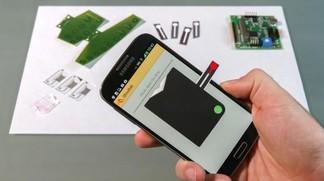The device would save patients frequent trips to a hospital medical laboratory and automatically transmit coag test results to attending physicians
Researchers in Switzerland are putting coagulation testing together with a smartphone specifically to allow patients to do home self-testing. This is another example of how technology is getting closer to moving medical laboratory tests out of the core lab and into near-patient settings.
This groundbreaking work is being done by researchers at École Polytechnique Fédérale de Lausanne (EPFL) [Swiss Federal Institute of Technology]. They want to develop a smartphone device that enables patients to monitor their own anticoagulation therapy at home, according to a report published by Fiercemobilehealthcare.com.
Most Coag Testing Usually Done in Central Clinical Laboratories
Anticoagulant therapy uses drugs to thin blood and prevent clotting, thus reducing the risk of heart attack and stroke. This therapy currently requires frequent blood flow monitoring, typically done by a central clinical laboratory. This new smartphone device would enable patients to monitor their own blood flow at home or anywhere. It would also speed delivery of the coag test results to attending physicians.
“Such a test will significantly improve the quality of life for people undergoing this kind of treatment,” stated Arther Queval, Founder of Qloudlab. This is the commercial startup in the institute’s microengineering laboratory that is developing the device.

This is the smartphone device now being developed by Qloulab, a commercial start-up within the Swiss Federal Institute of Technology’s microengineering laboratory. This device monitors blood flow in patients undergoing anticoagulant therapy. The gadget would allow patients to perform this test at home, saving them the need to travel to medical laboratory to provide specimens for coagulation testing. (Photo copyright Alain Herzog.)
How This Smartphone Gadget Works
The coagulation test gadget consists of a small, single-use film that attaches to the smartphone screen. The film consists of a microstructured plastic layer a few micrometers thick that acts as an electrical field, explained the Fiercemobilehealthcare.com report. A drop of blood on the film interacts with molecules in the film layer that initiate coagulation of the blood drop, noted a report from medicalnewstoday.com.
Special software, also created by Qloudlab, analyzes disruptions in the electric field on the surface of the smartphone screen to produce a diagnostic result. A special app enables the result to be sent in real-time directly to the patient’s physician to determine if the patient’s treatment needs to be modified.
The research team hopes to begin marketing the coagulation test device by the end of 2015.
The Future of Next-Generation Smartphone Apps and Devices
Smartphone apps are evolving swiftly. Early features simply tracked heart rate and fitness activity. Now entering the market are more complex, next-gen smartphone healthcare apps and devices that monitor key vital signs, such as blood pressure, temperature, and blood oxygen. These newer devices can also test blood sugar; perform a urine test that diagnoses up to 25 dieases; serve as an endoscope or optical imaging diagnostic tool; and even help detect lung cancer, noted the Fiercemobilehealthcare.com article. Additionally, medicalnewstoday.com cited creation of a portable device by researchers at the University of California Los Angeles that conducts kidney function tests and transmits the results through a smartphone attachment.
Medical Applications on Smartphones Attracting Regulators’ Attention
The Fiercemobilehealthcare.com report noted that, as these smartphone apps and devices become more complex in the types of medical functions they support, government agencies that regulate medical equipment are giving them increased scrutiny. The article noted, for example, that Samsung’s new Galaxy S5 smartphone is undergoing regulatory review by the South Korean government due to its built-in heart-rate sensor.
The introduction of increasingly-sophisticated diagnostic devices integrated with smartphones presents pathologists and clinical laboratory scientists with some interesting challenges. Will such devices have the high level of analytical accuracy and reproducibility that is required of top-flight medical laboratories? Also relevant for laboratory professionals is how to get the diagnostic test results generated by the smartphone device to populate the patient’s medical laboratory test record.
—by Patricia Kirk
Related Information:
Smartphones may be the next-gen blood test laboratory
Researchers create smartphone device that performs blood tests
New iPhone App Allows Consumers to Test Their Urine on the Go for as Many as 25 Different Diseases
Novel smartphone case measures key vital signs
Smartphone device can test for kidney damage
Clinical Pathology Laboratories Ignore the Rapid Growth of Mobile Apps in Healthcare at Their Peril



